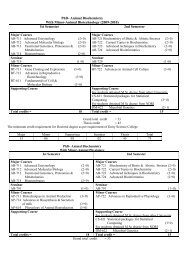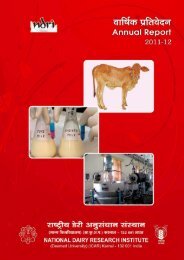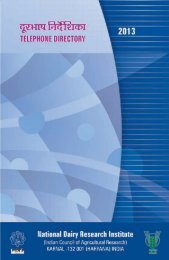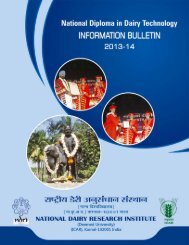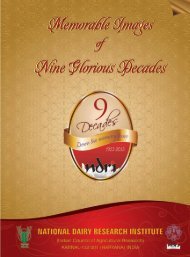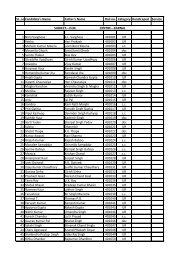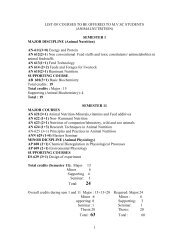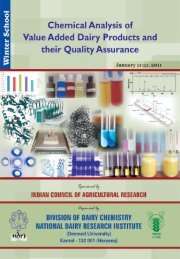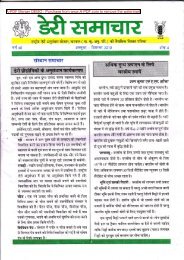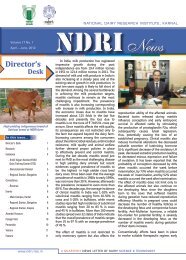NDRI Quinquennium Book COVER FINAL CURVE.cdr
NDRI Quinquennium Book COVER FINAL CURVE.cdr
NDRI Quinquennium Book COVER FINAL CURVE.cdr
Create successful ePaper yourself
Turn your PDF publications into a flip-book with our unique Google optimized e-Paper software.
esistance. Further, molecular characterization of MHC IIBoLA DRB3 and DQAI polymorphism were also studied.Animals with specific BoLA typing were considered forvaccination. In vitro proliferative response measurements wereconducted with the lymphocytes isolated from experimentallyvaccinated calves of Deoni and Malnad Gidda. The averageproliferation index with inactivated virus reached 3.7 in Deoniand 5.7 in Malnad Gidda native cattle indicating MalnadGidda showed higher cellular response to FMDV antigen andsub viral practices than Deoni breed. BoLA typing studiesshowed that locus DRB3.* 11, 15, and 9 were more prevalentin Malnad Gidda cattle than Deoni. Studies on immuneresponse in vaccinated animals showed that animals withBoLA DRB3.2*15 in Malnad Gidda cattle more resistantthan other genotypes. Malnad Gidda cattle which did notshow any antibody titres (log0.9) in prevaccinated serashowed maximum antibody titres of log2.7 indicating that theanimals expressed 10 fold high antibody responses with singleinjection. This indicates that Malnad Gidda animals mountrobust immune response to the virus as and when the animal isexposed to the pathogen, which helps in rapid clearance of thevirus from the mucosal tissue. Hence, Malnad Gidda breed ofcattle has been proven to be disease resistant/tolerant againstFMD, which has been reported first time in India.The<strong>Quinquennium</strong> Golden2007-2012••The Simple Regressed Least Squares (SRLS) and BestLinear Unbiased Prediction (BLUP) methods, followed byLeast Square (LS) were better than others for estimatingthe breeding values of dairy bulls under field conditions.••Characterization of BoLA DRB3.2 alleles under bovineMHC locus was carried out in Hallikar and Deoni nativebreeds of cattle.••The dairy farmers in Kerala are facing the constraintsof high cost of roughages and feed and feeding relatedreproductive problems, which is resulting in diminishingmilk production.••The studies on incidence of mastitis in Bangalore and Kolardistricts of Karnataka revealed that the overall prevalence ofMalnad Gidda cattle in its Native Tractsubclinical and clinical mastitis in crossbred cows (N=507)using CMT was 22.09 and 4.34 %, respectively, theincidence of mastitis was found to be higher in graded HF(28.69 %) followed by HF crossbred (19.64 %) and Jerseycrossbred (20.51 %).••Deoni cattle exhibited significantly better degree of oestrussymptoms.••The overall incidence of hoof disorders in dairy cows inthe region (N=456) was 28.3 %, the occurrence of hoofproblems was found to be highest in graded HF cows (35.2%), followed by HF crossbreds (10%) and Jersey crosses(5.6 %).33



